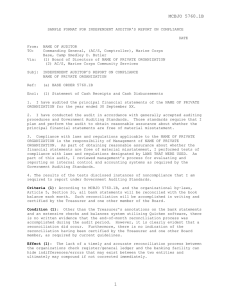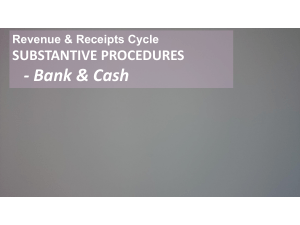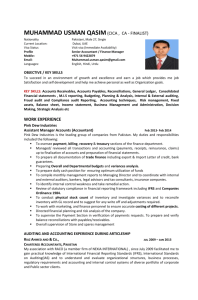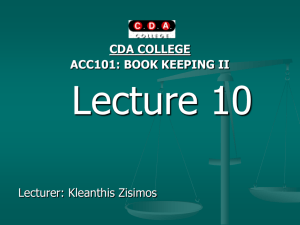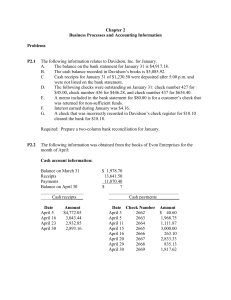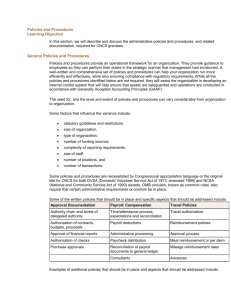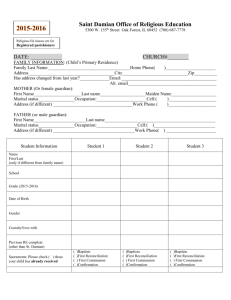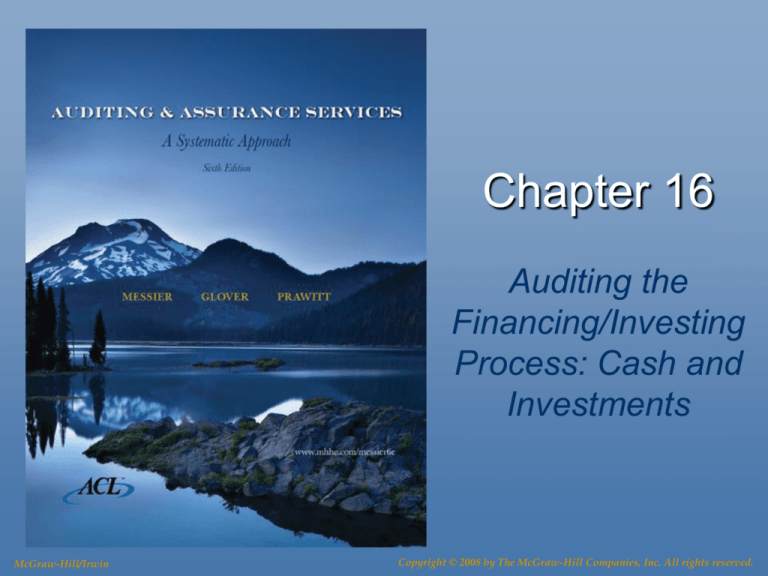
Chapter 16
Auditing the
Financing/Investing
Process: Cash and
Investments
McGraw-Hill/Irwin
Copyright © 2008 by The McGraw-Hill Companies, Inc. All rights reserved.
LO# 1
Cash and the Effect of
Other Business Processes
“Cash” reported in the financial statements
represents currency on hand and cash on deposit
in bank accounts, including certificates of deposit,
time deposits, and savings accounts.
“Cash equivalents” are frequently combined with
cash for presentation in the financial statements.
Definition: Short-term, highly liquid investments
that are readily convertible to cash or so near their
maturity that there is little risk of change in their
value.
Examples: Treasury bills; commercial paper; and
money market funds.
16-2
Cash and the Effect of
Other Business Processes
LO# 1
16-3
LO# 2
Types of Bank Accounts
Types of Bank
Accounts
General Cash
Account
Imprest Cash
Accounts
Branch
Accounts
In order to maximize its cash position, an entity
implements procedures for accelerating the collection
of cash receipts and properly delaying the payment of
cash disbursements.
16-4
Substantive Analytical
Procedures—Cash
LO# 3
&4
Because of the residual nature of
the cash account, the auditor’s
use of substantive analytical
procedures for auditing cash is
limited to . . .
comparisons with
prior years’ cash
balances.
comparisons with
budgeted amounts.
This limited use of substantive analytical procedures is normally offset by
(1)
extensive tests of controls and/or substantive tests of transactions for cash
receipts and disbursements or (2) extensive tests of the entity’s bank
reconciliations.
16-5
Substantive Tests of Details
of Transactions and Balances
LO# 3
&4
16-6
LO#
3,
4, & 5
The Effects of Controls
Controls for
Cash
Disbursement
s
Controls for
Cash Receipts
The reliability of the client’s
controls over cash affects
the nature and extent of the
auditor’s tests of details.
Completion of
Monthly Bank
Reconciliation
16-7
LO# 3
&4
Balance-Related Assertions
16-8
Auditing the General Cash
Account
Copy of Bank
Reconciliation
LO# 5
To audit a cash account,
the auditor should
obtain these items.
Standard Bank
Confirmation
Cutoff Bank
Statement
16-9
Bank Reconciliation
Working Paper
LO# 5
16-10
Standard Bank
Confirmation Form
LO# 5
16-11
LO# 5
Cutoff Bank Statement
Date of Last
Bank
Reconciliation
7 to 10
Days
A cutoff bank statement normally covers the 7- to 10-day
period after the date on which the bank account is
reconciled.
Any reconciling item should have cleared the client’s
bank account during the 7- to 10-day period.
16-12
LO# 5
Tests of the Bank Reconciliation
The auditor uses the following audit procedures to test the
bank reconciliation:
1. Test the mathematical accuracy and agree the balance per the books to
the general ledger.
2. Agree the bank balance on the reconciliation with the balance shown
on the standard bank confirmation.
3. Trace the deposits in transit on the bank reconciliation to the cutoff
bank statement.
4. Compare the outstanding checks on the bank reconciliation with the
canceled checks in the cutoff bank statement for proper payee, amount
and endorsement.
5. Agree any charges included on the bank statement to the bank
reconciliation.
6. Agree the adjusted book balance to the cash account lead schedule.
16-13
Auditing a Payroll or Branch
Imprest Account
LO# 5
The audit of any imprest cash account
such as payroll or a branch account
follows the same basic audit steps
discussed under the audit of the general
cash account.
16-14
LO# 5
Auditing Petty Cash
Usually not
material.
Potential for
defalcation.
Seldom perform
substantive
tests.
Document
controls.
16-15
LO# 5
Disclosure Issues for Cash
16-16
LO# 5
Disclosure Issues for Cash
16-17
LO# 5
Disclosure Issues for Cash
16-18
LO# 6
Fraud-Related Audit Procedures
Extended Bank
Reconciliation
Procedures
Proof of Cash
Tests for Kiting
16-19
Extended Bank
Reconciliation Procedures
LO# 6
In some instances, the year-end bank reconciliation can
be used to cover cash defalcations. This is usually
accomplished by manipulating the reconciling items in
the bank reconciliation. For example, suppose a client
employee was able to steal $5,000 from the client. The
client’s cash balance at the bank would then be $5,000
less than reported on the client’s books. The employee
could “hide” the $5,000 shortage in the bank
reconciliation by including a fictitious deposit in transit.
16-20
LO# 6
Proof of Cash
16-21
LO# 6
Tests for Kiting
16-22
LO# 7
Investments
Common Stock
Preferred Stock
Debt Securities
Hybrid Securities
16-23
LO# 8
Control Risk Assessment—
Investments
Occurrence
and
Authorization
Here are some of the more
important assertions for
investments.
Completeness
Accuracy and
Classification
16-24
LO# 9
Segregation of Duties
16-25
LO# 10
Substantive Procedures
for Testing Investments
16-26
Tests of Details—Investments
Existence
Auditing Standards state that the auditor should
perform one of the following procedures when
gathering evidence for existence:
Physical examination
Confirmation with the issuer
Confirmation with the custodian
Confirmation of unsettled transactions with the
broker-dealer
Confirmation with the counterparty
Reading executed agreements
16-27
Tests of Details—Investments
Valuation and Allocation
The auditor must also determine if there has
been any permanent decline in the value of
an investment security. Auditing and
accounting standards provide guidance for
determining whether a decline in value
below amortized cost is other than
temporary.
16-28
Tests of Details—Investments
Valuation and Allocation
Here are some factors that may indicate a non-temporary
impairment of investment value:
Fair value is significantly below cost
Decline in fair value is attributable to specific adverse
conditions
Management does not possess both the intent and
ability to hold the investment long enough to allow for
recovery in fair value
A debt security has been downgraded by a rating
agency
The financial condition of the issuer has deteriorated
Permanently Impaired = Write down to new carrying amount
16-29
Tests of Details—Investments
Disclosure Assertions
Marketable securities need to be properly
classified as held-to-maturity, trading, and
available-for-sale.
Held-to-maturity securities and individual
available-for-sale securitieds should be
classified as current or non-current assets
based on whether management expects to
convert them to cash within 12 months
All trading securities should be classified as
current assets
16-30
End of Chapter 16
16-31

